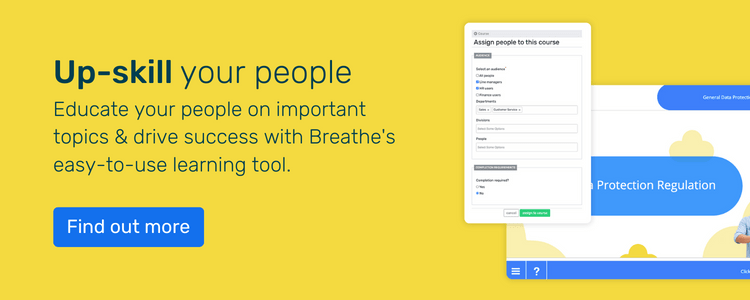Discrimination can take many forms and not all are direct or obvious. Sometimes, the rules and policies you made with the best intentions can end up treating an individual or group of employees unfairly. This is indirect discrimination and is it is against the law. In this guide we will help you learn more about indirect discrimination and how you can start removing it from your workplace.
What is indirect discrimination?
Indirect discrimination is the result of a workplace policy that is applied to everyone in the company in the same way. When this policy ends up disadvantaging an individual or group which share the same 'protected characteristic' it is indirect discrimination.
In short, indirect discrimination is when you treat an individual or group of employees the same as everyone else, but this ends up negatively affecting them.
On the face of it, treating all employees equally sounds like a great idea. But applying a blanket policy or rule does not take into consideration how race, religion, age and other protected characteristics can face unfair treatment.
Even though your workplace policies are put in place with the best intentions, without considering the needs of those with 'protected characteristics', you may end up indirectly discriminating against them.
Want to learn more about direct discrimination? Read our guide to what direct discrimination looks like in the workplace.
What does the law say about indirect indiscrimination?
Under the Equality Act 2010, you will be committing an employment offence if you indirectly discriminate against an individual or group of employees with a protected characteristic.
These protected characteristics include:
- Age
- Disability
- Gender reassignment
- Marriage and civil partnership
- Pregnancy and maternity
- Race
- Religion and belief
- Sex
- Sexual orientation
If a person or group within one or more of these categories feels as though a policy at work discriminates against them, they can use this law to take further action.
Examples of indirect discrimination in the workplace
To help you understand and develop context, here are some examples:
Indirect discrimination relating to sex and pregnancy
It can be considered indirect discrimination If an employee on maternity leave puts in a flexible working request to reduce their hours for childcare but is rejected due to company policy. For example, if the manager refuses because of a policy which states all staff are required to work full time. In this situation the employee will have a case for indirect sex discrimination.
In this case, the rule for all employees has a worse effect on women than it does compared to men. Statistically women are more likely to provide home care for their children, meaning they are more likely to require flexible work to raise their children.
Indirect discrimination in relation to religion
An example of the indirect discrimination applied to religion is as follows:
An employer sets a company policy which states that all employees must work a Saturday shift. In this case, it does not consider the religious needs of groups or individual employees.
For example, if the company hires employees practicing Judaism, they would not be able to work on a Saturday, as the sabbath is a religious day. If the individual or group are asked to work on this day, and a request not to work is disregarded, the receiving party will be able to claim indirect religious discrimination. In this situation, the group or individual will not be able to practice their religion.
You can avoid this situation with effective work rota software that takes into consideration the needs of all employees.
Indirect discrimination relating to race
Here is another example, but this time in relation to race.
If an individual has moved to the UK and gained the correct permissions to work but refrained from applying for the role because their equivalent qualifications are not accepted by the employer. This can act as a case for indirect racial discrimination.
The indirect discrimination in action here is that the qualification policy implemented by the employer prevents those educated outside the UK from applying for their role. It discriminates against the value of education outside the UK, even though it could be of equivalent, or even higher value.
Indirect discrimination in relation to disability
Recruitment can often provide occasions of indirect discrimination. Those with disabilities can often find ‘fair’ policies put them at a disadvantage.
For example, an applicant with Asperger's syndrome can find that a multiple-choice situational judgement test can put them at a disadvantage. In this case, the said individual may put forward an alternate method of testing such as writing their answer in a short narrative form.
However, if the recruiter rejects this request without sound objective justification it can be classed indirect discrimination. In this example a different method was provided but was rejected on the grounds of a blanket policy. This would have the effect of putting the individual with Asperger's at a disadvantage, as they will not be able to perform to the best of their abilities.
How to deal with claims of indirect discrimination
The best way to deal with claims of indirect discrimination is to create a workplace culture where grievances can be made by employees without risk to their employment status.
In these situations, an employee can raise their concerns about indirect discrimination with their line manager without consequences.
All grievances, once formal, should have a case built by establishing facts, collecting evidence and interviewing witnesses. This should all be done in line with the protected characteristics outlined in the Equality Act 2010.
Support your employees with an equal opportunities policy
By implementing an equal opportunities policy, you can set your company apart in valuing diversity and opposing discrimination.
Having an equal opportunities policy demonstrates that your organisation is aware and looking out for all counts of discrimination. It will outline that all forms of discrimination in relation to the 'protected characteristics' will not be tolerated under any circumstances.
How can indirect discrimination be avoided?
The best way to reduce the risk of indirect discrimination is to build fairness into your policies and create space for feedback from your team.
Start by looking at any workplace rules or practices that apply to everyone. Could they be making things harder for someone because of a protected characteristic?
Here are a few ways to help prevent issues:
-
Keep your policies under review
Spot and update anything that could unintentionally exclude or disadvantage people. -
Support your managers with training
Help them recognise the signs of indirect discrimination and understand how to respond. -
Offer flexibility where you can
Especially when it comes to working hours, locations or how you assess people. -
Make it safe to speak up
Encourage people to share concerns early, without fear of judgement.
Taking these steps can help you build a workplace that’s inclusive, fair and ready to support everyone.
Why it's important to remove indirect discrimination from the workplace
Removing indirect discrimination from your workplace can foster a greater company culture through diversity and inclusivity.
Increasing the diversity of your company, by welcoming those with protected characteristics can promote exciting new thinking though different cultural and life perspectives.
With a wider range of ideas, skills and perspectives you can boost the productivity of your workplace. Alongside this, by acting against indirect discrimination your company brand will improve, with people seeing it as progressive place to work and be associated with.
Create a diverse and dynamic workplace culture with Breathe
Create a diverse and dynamic workplace by kickstarting your recruitment with our easy-to-use tools. Our software lets you take ownership of every stage of the recruitment process from posting vacancies to employment in a couple of clicks. Manage, develop and retain your talent with HR software that helps your business grow.
Author: Andy Stewart
.webp)



